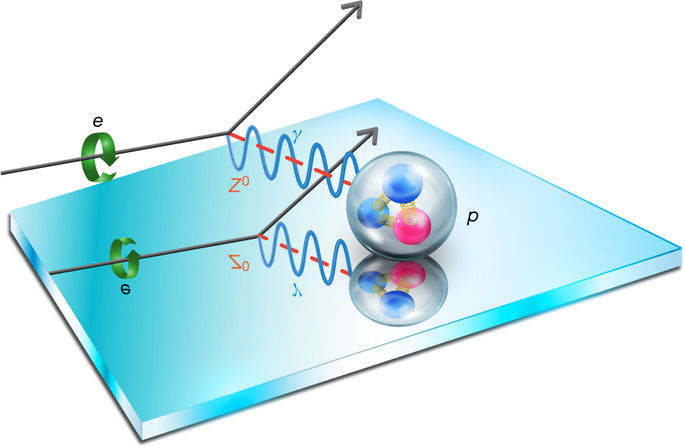Our official English website, www.x-mol.net, welcomes your feedback! (Note: you will need to create a separate account there.)
Precision measurement of the weak charge of the proton
Nature ( IF 64.8 ) Pub Date : 2018-05-01 , DOI: 10.1038/s41586-018-0096-0
Nature ( IF 64.8 ) Pub Date : 2018-05-01 , DOI: 10.1038/s41586-018-0096-0

|
Large experimental programmes in the fields of nuclear and particle physics search for evidence of physics beyond that explained by current theories. The observation of the Higgs boson completed the set of particles predicted by the standard model, which currently provides the best description of fundamental particles and forces. However, this theory’s limitations include a failure to predict fundamental parameters, such as the mass of the Higgs boson, and the inability to account for dark matter and energy, gravity, and the matter–antimatter asymmetry in the Universe, among other phenomena. These limitations have inspired searches for physics beyond the standard model in the post-Higgs era through the direct production of additional particles at high-energy accelerators, which have so far been unsuccessful. Examples include searches for supersymmetric particles, which connect bosons (integer-spin particles) with fermions (half-integer-spin particles), and for leptoquarks, which mix the fundamental quarks with leptons. Alternatively, indirect searches using precise measurements of well predicted standard-model observables allow highly targeted alternative tests for physics beyond the standard model because they can reach mass and energy scales beyond those directly accessible by today’s high-energy accelerators. Such an indirect search aims to determine the weak charge of the proton, which defines the strength of the proton’s interaction with other particles via the well known neutral electroweak force. Because parity symmetry (invariance under the spatial inversion (x, y, z) → (−x, −y, −z)) is violated only in the weak interaction, it provides a tool with which to isolate the weak interaction and thus to measure the proton’s weak charge1. Here we report the value 0.0719 ± 0.0045, where the uncertainty is one standard deviation, derived from our measured parity-violating asymmetry in the scattering of polarized electrons on protons, which is −226.5 ± 9.3 parts per billion (the uncertainty is one standard deviation). Our value for the proton’s weak charge is in excellent agreement with the standard model2 and sets multi-teraelectronvolt-scale constraints on any semi-leptonic parity-violating physics not described within the standard model. Our results show that precision parity-violating measurements enable searches for physics beyond the standard model that can compete with direct searches at high-energy accelerators and, together with astronomical observations, can provide fertile approaches to probing higher mass scales. Measurement of the asymmetry in the parity-violating scattering of polarized electrons on protons gives the weak charge of the proton as 0.0719 ± 0.0045, in agreement with the standard model.
中文翻译:

精确测量质子弱电荷
核物理和粒子物理学领域的大型实验计划寻找超出当前理论解释的物理学证据。希格斯玻色子的观测完成了标准模型预测的粒子集,它目前提供了对基本粒子和力的最佳描述。然而,该理论的局限性包括无法预测基本参数,例如希格斯玻色子的质量,以及无法解释暗物质和能量、引力以及宇宙中的物质-反物质不对称等现象。这些限制激发了在后希格斯时代通过在高能加速器中直接产生额外粒子的标准模型之外的物理学研究,但迄今为止尚未成功。示例包括搜索超对称粒子,它将玻色子(整数自旋粒子)与费米子(半整数自旋粒子)连接起来,以及搜索轻夸克,将基本夸克与轻子混合。或者,使用准确预测的标准模型观测值的精确测量进行间接搜索,可以对超出标准模型的物理学进行高度针对性的替代测试,因为它们可以达到超出当今高能加速器可直接访问的质量和能量尺度。这种间接搜索旨在确定质子的弱电荷,它定义了质子通过众所周知的中性电弱力与其他粒子相互作用的强度。因为奇偶对称性(空间反转 (x, y, z) → (-x, -y, -z) 下的不变性)仅在弱相互作用中被违反,它提供了一种工具来隔离弱相互作用,从而测量质子的弱电荷1。在这里,我们报告了 0.0719 ± 0.0045 的值,其中不确定性是一个标准偏差,源自我们测量的质子上极化电子散射的违反奇偶校验的不对称性,即 -226.5 ± 9.3 ppb(不确定性是一个标准偏差) )。我们对质子弱电荷的值与标准模型 2 非常一致,并且对标准模型中未描述的任何半轻子奇偶校验违反物理设置了多兆电子伏级的约束。我们的结果表明,精确的违反奇偶校验的测量可以实现超出标准模型的物理搜索,可以与高能加速器的直接搜索相竞争,并与天文观测一起,可以提供有效的方法来探测更高的质量尺度。质子上极化电子违反奇偶校验散射的不对称性的测量给出了质子的弱电荷为 0.0719 ± 0.0045,与标准模型一致。
更新日期:2018-05-01
中文翻译:

精确测量质子弱电荷
核物理和粒子物理学领域的大型实验计划寻找超出当前理论解释的物理学证据。希格斯玻色子的观测完成了标准模型预测的粒子集,它目前提供了对基本粒子和力的最佳描述。然而,该理论的局限性包括无法预测基本参数,例如希格斯玻色子的质量,以及无法解释暗物质和能量、引力以及宇宙中的物质-反物质不对称等现象。这些限制激发了在后希格斯时代通过在高能加速器中直接产生额外粒子的标准模型之外的物理学研究,但迄今为止尚未成功。示例包括搜索超对称粒子,它将玻色子(整数自旋粒子)与费米子(半整数自旋粒子)连接起来,以及搜索轻夸克,将基本夸克与轻子混合。或者,使用准确预测的标准模型观测值的精确测量进行间接搜索,可以对超出标准模型的物理学进行高度针对性的替代测试,因为它们可以达到超出当今高能加速器可直接访问的质量和能量尺度。这种间接搜索旨在确定质子的弱电荷,它定义了质子通过众所周知的中性电弱力与其他粒子相互作用的强度。因为奇偶对称性(空间反转 (x, y, z) → (-x, -y, -z) 下的不变性)仅在弱相互作用中被违反,它提供了一种工具来隔离弱相互作用,从而测量质子的弱电荷1。在这里,我们报告了 0.0719 ± 0.0045 的值,其中不确定性是一个标准偏差,源自我们测量的质子上极化电子散射的违反奇偶校验的不对称性,即 -226.5 ± 9.3 ppb(不确定性是一个标准偏差) )。我们对质子弱电荷的值与标准模型 2 非常一致,并且对标准模型中未描述的任何半轻子奇偶校验违反物理设置了多兆电子伏级的约束。我们的结果表明,精确的违反奇偶校验的测量可以实现超出标准模型的物理搜索,可以与高能加速器的直接搜索相竞争,并与天文观测一起,可以提供有效的方法来探测更高的质量尺度。质子上极化电子违反奇偶校验散射的不对称性的测量给出了质子的弱电荷为 0.0719 ± 0.0045,与标准模型一致。



























 京公网安备 11010802027423号
京公网安备 11010802027423号